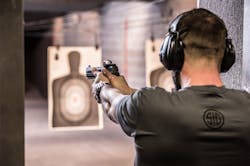Contemporary L.E. Handgun Selection
Today’s law enforcement handgun—the primary lethal force weapon for all officers—is most likely to have a polymer frame, double stack magazine, approximately a four inch long barrel, some type of safety (integral or otherwise) and night sights. That’s not to say, however, that any handgun meeting those criteria is acceptable as a duty weapon. While most agencies specify a caliber, capacity and price point for a new handgun selection, many ignore what will ultimately become of greater concern: the comfort, competence and confidence of their officers with the selected firearm.
For the sake of this article, let’s review recommendations for the specific mechanical characteristics that might make a handgun desirable for duty use. We’ll also look at the more subjective considerations that can heavily impact how well the weapon is received by the department and how well the officers perform with it in actual shootings.
Three calibers dominate LE handguns
Discovered in a recent survey conducted by SouthComm Law Enforcement Media, three calibers make up the large bulk of issued law enforcement handguns today: 9mm, .40S&W and .45ACP. Those three calibers combined account for 97.4 percent of issued handguns in America. Each of those calibers has its own pros and cons.
The 9mm is the NATO military round and, as such, is guaranteed reasonable pricing for the foreseeable future. Additionally, with its smaller diameter cartridge body, you can fit more of them into a staggered magazine than you can either of the other two calibers.
The .40S&W is a happy compromise between the 9mm and the .45ACP allowing it some of the strengths of each. Since .40 equals 10 mm, you’re only looking at a 1 mm increase in diameter so you can still get a fair number of cartridges into a staggered magazine. But because of that larger diameter you also get larger wound channels which equates to a faster stoppage of the threat—assuming accurate hits on target.
The .45ACP has perhaps the best proven performance record having stood as the American military sidearm caliber for about 75 years (1911 to 1985). The trade-off for the larger caliber round is fewer of them in the weapon and a slower moving projectile. The wound channel tends to be pretty aggressive though and there’s a reduced chance of over-penetration in the target. These aren’t the only three acceptable calibers, though.
There are several other viable options which would include the .357Sig, the 10mm and the .45GAP cartridges. Given that there is such a decreased demand for these cartridges, the cost for them tends to be a bit higher. I know that goes against the laws of supply and demand as we know it, but it’s how things work in the ammo industry. The rarer a cartridge is, the higher its cost.
Where the .45ACP is longer, the .45GAP is shorter and allows for a bit of double-stacking/staggering in the magazine. The result is a few more rounds in the weapon and a projectile that has identical external and terminal ballistic properties. The 10mm and the .40S&W are a similar comparison. The case on the 10mm cartridge is longer than that of the .40S&W even though they are identical in diameter. The .40S&W is, in essence, a shortened 10mm cartridge and grew out of the FBI’s desire for a lightened 10mm load.
The .357Sig is a .357 caliber projectile loaded into a necked down .40 caliber case. This has two strengths: it allows for enough powder charge to push that projectile at 1,400+ fps out of the barrel and it allows for .40S&W chambered weapons to be easily converted by just switching out the barrel. The downside of it is, again, cost and the fact that some shooters complain about the recoil being a bit sharp. That is one of those subjective items that needs to be considered by an agency when selecting a new handgun.
Reality is that many agencies will do whatever the FBI does in selecting a handgun caliber. Roughly 35 years ago when the agency moved to the 10mm and helped evolve it into the .40S&W, law enforcement agencies also began to move to the .40S&W. Recently the FBI decided to move back to the 9mm and a lot of America’s law enforcement are following suit. Before you switch calibers consider why you’re doing so.
The caliber you select is directly connected to the capacity available for your duty weapon. If you choose a 9mm, you can get a good quality, reasonably priced polymer framed handgun that holds 17 or more rounds in a single magazine. If you choose the .40S&W, you can get a similar weapon that holds 15 rounds per magazine. If you choose the .45ACP you can get a similar weapon that holds 13 rounds—but requires bigger hands to hold, manipulate and shoot.
While law enforcement agencies are exempted (usually) from state restrictions on magazine capacity, some agencies prefer to stay within the legal limits, no matter how artificially set they are. That means a 10 round magazine no matter what caliber you choose. What you have to determine prior to selecting a handgun is what minimum capacity you consider acceptable. There’s no such thing as “too much” ammunition, but there certainly can be “not enough.”
Barrel length
Moving on from caliber and capacity, most agencies require a four inch minimum barrel length and that translates to a site radius of about six inches—give or take a small amount. The site radius is the distance between the rear site and the front site. The longer the radius, the more inherently accurate our aim can be. The shorter the radius, the easier it is to miss. While there may be exceptions made for plainclothes and/or undercover work, most agencies require four inch barrel length for uniformed issue.
The so-common polymer frame of today is also a good design feature, but far from mandatory. It’s usually preferred as it allows for a lighter weight weapon and the ability to be “color coded” if an agency orders a sufficient quantity. Most handgun frames have an accessory rail now, but just because it’s there doesn’t mean it has to be used.
Whether or not the weapon has a manual safety is often a deciding point as well. The Glock has three safeties but none of them is considered an “external manual safety.” They are automatically disconnected as you pull the trigger and reconnected as the weapon cycles back into battery. The Beretta has a “decocking manual safety,” which serves not only to decock the weapon after a round is chambered but also disconnects the trigger bar from the sear so pulling the trigger does nothing if the safety is “on.” There are pros and cons to manual safeties, most of which include training concerns. Your agency has to decide whether or not to require such on a duty weapon.
Comfort, confidence, competence
Now, as to those subjective items like comfort, confidence and competence, your agency can pick the absolutely best handgun in the world, but if it’s too big to fit the hands of your smallest officer, if the recoil is too harsh to be handled by your weakest officer or if your officers simply don’t believe it will perform when required, then you have issues. Unfortunately, there is no “best fit” for everyone. In today’s world of double-stack 17+ round capacity magazines, the polymer frame grips have a circumference that will inevitably make it too big for those with small hands (this author included). Having grips that are too big for the hands translates into improper grip while firing and that translates into challenges when qualifying and when officers are involved in actual shooting situations. That means lower comfort and lower competence—and that results in lower confidence.
If it’s at all possible, within your agency’s operating structure, select a handgun that allows for variable grip sizes. For instance, the 4th generation of Glocks have interchangeable backstraps that allow for adjusting overall circumference. That can translate into a more comfortable grip for shooters dependent on hand size.
Heckler & Koch makes the P7 model of pistol in eight- or 13-round capacities. Bigger hands can handle the 13-round capacity while smaller hands can accommodate the eight.
Is having less ammunition in the gun bad? In an actual shooting maybe, but does the extra ammo do you any good if you can’t shoot the weapon properly to begin with? Absolutely not.
Your agency shouldn’t be picking a weapon based purely on caliber, capacity, barrel length, etc. Use those design characteristics as a semi-flexible foundation for selection and then adjust as necessary so that every officer on the agency can be issued a weapon that meets the basic need—one that is comfortable, competent and confident for them.
The Army changes handguns
Earlier this year the U.S. Army selected the Sig Sauer P320 as its new M17 issued handgun. This polymer framed 9mm handgun is equipped with fully ambidextrous controls for the slide stop and manual safety. With its 17 round capacity—and available 21 round magazines for increased capacity—the handgun is slated to enter military service soon. Just as the military’s adoption of the Beretta 92FS as the M9 handgun in 1985 boosted sales of that particular weapon and jump-started the transition in law enforcement from revolvers to semi-autos, the choice of the Army to purchase the Sig Sauer P320 / M17 9mm will surely push more agencies towards polymer framed, higher capacity, 9mm handguns.
What about accessories such as holsters, lights, etc.? Don’t worry. The market will accommodate. Any handgun that is selling in sufficient quality will have a number of holster options. All major holster manufacturers will be competing for marketshare and to do so they have to produce holsters for the majority of handguns being used as duty weapons. As for lights, with almost all polymer framed handguns having a Picatinny rail now, it’s easy to mount nearly any light on the market. The trick is finding a holster that will securely hold your selected handgun with your selected light mounted. There are several out there so shop around and select the one that best suits not only your needs but also your agency’s ethos regarding training and protocols for weapon mounted lights.
About the Author
Lt. Frank Borelli (ret), Editorial Director
Editorial Director
Lt. Frank Borelli is the Editorial Director for the Officer Media Group. Frank brings 20+ years of writing and editing experience in addition to 40 years of law enforcement operations, administration and training experience to the team.
Frank has had numerous books published which are available on Amazon.com, BarnesAndNoble.com, and other major retail outlets.
If you have any comments or questions, you can contact him via email at [email protected].

